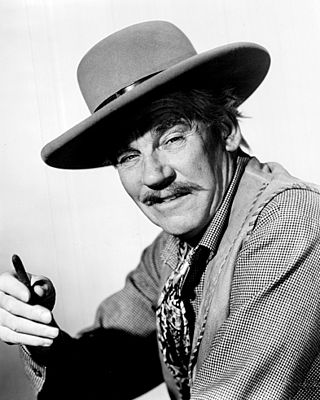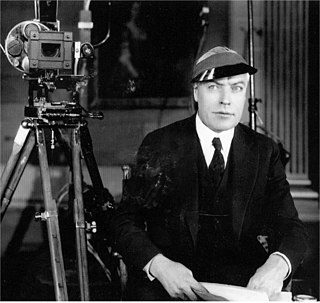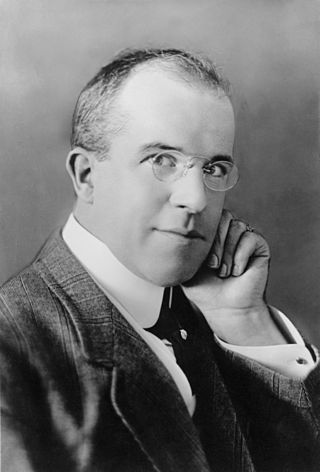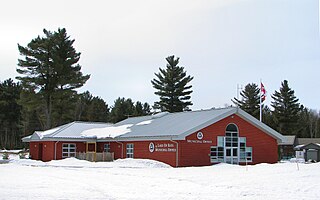Related Research Articles

Allan Dwan was a pioneering Canadian-born American motion picture director, producer, and screenwriter.

John Grierson was a pioneering Scottish documentary maker, often considered the father of British and Canadian documentary film. In 1926, Grierson coined the term "documentary" in a review of Robert J. Flaherty's Moana.

Stop motion is an animated filmmaking technique in which objects are physically manipulated in small increments between individually photographed frames so that they will appear to exhibit independent motion or change when the series of frames is played back. Any kind of object can thus be animated, but puppets with movable joints or plasticine figures are most commonly used. Puppets, models or clay figures built around an armature are used in model animation. Stop motion with live actors is often referred to as pixilation. Stop motion of flat materials such as paper, fabrics or photographs is usually called cutout animation.

Walter Thomas Huston was a Canadian actor and singer. Huston won the Academy Award for Best Supporting Actor for his role in The Treasure of the Sierra Madre, directed by his son John Huston. He is the patriarch of the four generations of the Huston acting family, including his son John, grandchildren Anjelica Huston and Danny Huston, as well as great-grandchild Jack Huston. The family has produced three generations of Academy Award winners: Walter, his son John, and granddaughter Anjelica.

Norman Frederick Jewison was a Canadian filmmaker. He was known for directing films which addressed topical social and political issues, often making controversial or complicated subjects accessible to mainstream audiences. Among numerous other accolades, he was nominated for the Academy Award for Best Director three times in three separate decades, for In the Heat of the Night (1967), Fiddler on the Roof (1971), and Moonstruck (1987). He was nominated for an additional four Oscars, three Golden Globe Awards, and a Primetime Emmy Award, and won a BAFTA Award. He received the Academy of Motion Pictures Arts and Sciences's Irving G. Thalberg Memorial Award in 1999.

Delmer "Del" Lord was a Canadian film director and actor best known as a director of Three Stooges films.

Sidney Olcott was a Canadian-born film producer, director, actor and screenwriter.

James Stuart Blackton was a British producer and director of the silent era. One of the pioneers of motion pictures, he founded Vitagraph Studios in 1897. He was one of the first filmmakers to use the techniques of stop-motion and drawn animation, is considered a father of American animation, and was the first to bring many classic plays and books to the screen. Blackton was also the commodore of the Motorboat Club of America and the Atlantic Yacht Club.

Cinema in Canada dates back to the earliest known display of film in Saint-Laurent, Quebec, in 1896. The film industry in Canada has been dominated by the United States, which has utilized Canada as a shooting location and to bypass British film quota laws, throughout its history. Canadian filmmakers, English and French, have been active in the development of cinema in the United States.

Lake of Bays is a township municipality within the District Municipality of Muskoka, Ontario, Canada. The township, situated 193 kilometres (120 mi) north of Toronto, is named after the Lake of Bays. During the 2016 census, the township had a population of 3,167 and encompassed 677.91 square kilometres (261.74 sq mi) of land.

Frank Radford "Budge" Crawley, was a Canadian film producer, cinematographer and director. Along with his wife Judith Crawley, he co-founded the production company Crawley Films in 1939.

The Metro-Goldwyn-Mayer cartoon studio was an American animation studio operated by Metro-Goldwyn-Mayer (MGM) during the Golden Age of American animation. Active from 1937 until 1957, the studio was responsible for producing animated shorts to accompany MGM feature films in Loew's Theaters, which included popular cartoon characters Tom, Jerry, Droopy, Butch, Spike, Tyke, and Barney Bear.
Associated Screen News of Canada (ASN) was a Montreal-based film production company which, from the mid-1920s to the 1950s, was the largest private film production company in Canada.
Chris Sparling is an American filmmaker from Providence, Rhode Island.
Terence Macartney-Filgate was a British-Canadian film director who directed, wrote, produced or shot more than 100 films in a career spanning more than 50 years.
Lawrence J. Darmour (1895–1942) was an American film producer, operator of Larry Darmour Productions from 1927, and a significant figure in Hollywood's low-budget production community.

Albert Edward Smith was an American stage magician, film director and producer, and a naturalized American. He founded Vitagraph Studios with his business partner James Stuart Blackton in 1897.
The Canadian Government Motion Picture Bureau, founded as the Exhibits and Publicity Bureau, was the film production agency of the Government of Canada administered by the Department of Trade and Commerce, and intended to promote trade and industry. Created in 1918, it was the first government film production organization in the world.

Arthur David Kean (1882–1961), often known as "Cowboy" Kean, was a Canadian filmmaker, journalist, broadcaster, photographer, and horseman. He was the first British Columbia resident to earn his living as a filmmaker, and the first to produce a feature film, the ill-fated Policing the Plains (1927).
Rhapsody in Two Languages is a Canadian short documentary film, directed by Gordon Sparling and released in 1934. The most famous film in the Canadian Cameo Series of short documentaries, the film is a portrait of life in the bilingual and bicultural city of Montreal during the Great Depression era.
References
- ↑ Sarah Jennings, "Gordon Sparling worked on one of the first Canadian features, helped record the country's role in the Second World War, and now a history occupies his time; Happy birthday to a Canadian pioneer". The Globe and Mail , August 13, 1990.
- ↑ Morris, Peter (2015) Gordon Sparling. The Canadian Encyclopedia Historica Canada